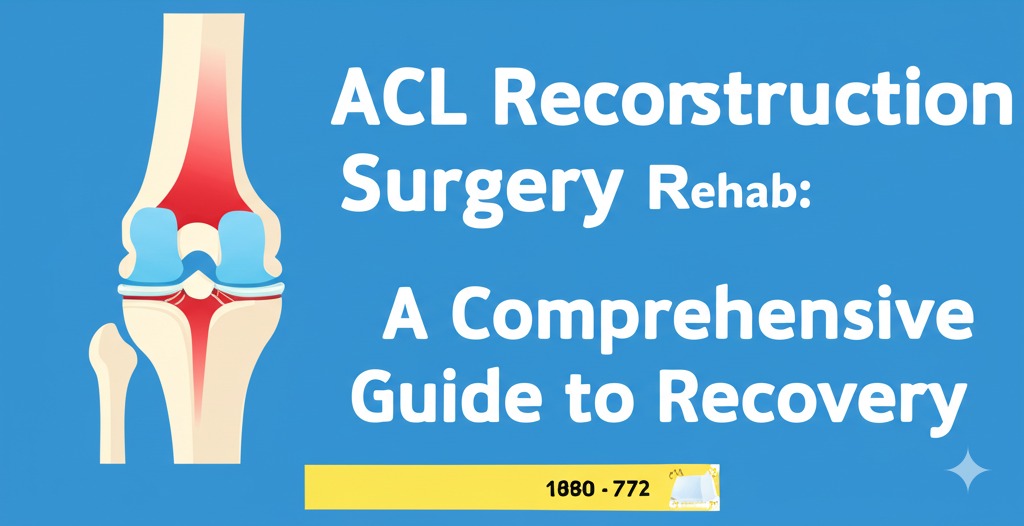Recovering from ACL reconstruction surgery is a crucial process that requires patience, dedication, and the right approach. Whether you’re an athlete eager to return to your sport or someone looking to regain everyday functionality, understanding the rehab process is key to achieving a full recovery. In this article, we’ll take you through the essential steps of ACL reconstruction surgery rehab, providing a detailed roadmap to help you get back on track.
What is ACL Reconstruction Surgery?
Before diving into the rehabilitation process, let’s briefly understand what ACL reconstruction surgery entails. The anterior cruciate ligament (ACL) is one of the key ligaments in the knee, responsible for stabilizing the joint. When this ligament is torn, typically from sports-related injuries or accidents, surgery is often required to repair the damage.
ACL reconstruction surgery involves replacing the torn ligament with a graft, usually taken from the patient’s own body or a donor. Post-surgery rehab is critical to ensure the knee regains its strength, stability, and range of motion.
The Phases of ACL Reconstruction Rehab
Rehabilitation after ACL reconstruction surgery is divided into several phases, each focusing on specific goals and recovery milestones. These phases are designed to help the knee heal properly and progressively regain strength.
Phase 1: Immediate Post-Surgery (Weeks 1–2)
The first few weeks after surgery are all about reducing pain, swelling, and inflammation. This phase focuses on protecting the knee and starting gentle movement exercises. Goals during this phase include:
- Pain management: Applying ice, taking prescribed medications, and elevating the leg.
- Range of motion (ROM): Gentle movements to restore knee flexibility, like straight leg raises and passive knee bends.
- Weight-bearing: Initially, you may need crutches or a knee brace to avoid putting weight on the affected leg.
Phase 2: Early Rehab (Weeks 3–6)
As the knee begins to heal, the focus shifts to increasing strength and mobility. This phase includes exercises that help improve the knee’s range of motion while reducing swelling and stiffness.
- Strengthening exercises: Gentle quad sets, hamstring curls, and calf raises.
- Weight-bearing: Gradually increase weight-bearing activities as the knee gets stronger.
- Flexibility training: Continue with exercises that promote the full range of motion.
Phase 3: Strengthening and Stability (Weeks 7–12)
By this stage, the knee should be getting stronger, and you can begin more advanced exercises aimed at restoring muscle strength and stability. This phase is critical for regaining knee function and preparing for more demanding activities.
- Strength exercises: Step-ups, leg presses, lunges, and squats.
- Proprioception training: Balancing exercises to improve the knee’s stability and prevent future injuries.
- Low-impact aerobic exercise: Swimming or stationary cycling can help increase cardiovascular fitness without stressing the knee.
Phase 4: Advanced Strengthening (Months 3–6)
This phase aims to restore functional strength and prepare the knee for more intense physical activity. As the knee becomes stronger, you can start engaging in sport-specific drills.
- Sport-specific training: Jumping drills, agility training, and cutting drills.
- Plyometrics: Exercises that involve jumping and explosive movements to build power.
- Endurance training: Running or cycling can help improve endurance without stressing the knee.
Phase 5: Return to Activity (6+ Months)
The final phase of ACL reconstruction rehab focuses on safely returning to full activity levels. It’s crucial to ensure that the knee is not only strong but also functional and capable of handling the demands of your sport or daily activities.
- Sport readiness tests: Functional testing to determine if you can return to sports.
- Return to full activity: Depending on your progress, you may be cleared to return to full athletic activity, including contact sports.
Key Tips for a Successful ACL Reconstruction Rehab
Rehabilitation after ACL surgery can be a long and challenging journey, but following these tips can help speed up your recovery:
- Follow your rehab protocol: Stick to the prescribed rehab exercises and avoid overexerting yourself.
- Stay patient and realistic: Healing takes time. Don’t rush the process or attempt activities that could jeopardize your recovery.
- Communicate with your healthcare team: Regular check-ins with your surgeon and physical therapist will help track your progress and adjust your rehab plan as needed.
- Maintain a healthy diet: Proper nutrition aids in healing and maintaining strength throughout the rehab process.
Common Mistakes to Avoid During ACL Rehab
While the rehab process is critical, there are several common mistakes that can delay recovery or even lead to further injury. Be sure to avoid these:
- Skipping rehab exercises: Inconsistent effort can lead to muscle weakness and a longer recovery time.
- Rushing back into sports: Returning to high-impact activities too soon can cause reinjury.
- Ignoring pain: Pushing through pain can cause damage to the knee and slow down the recovery process.
When to Seek Medical Help
Although many people can recover well from ACL surgery with the right rehabilitation, some may experience complications or setbacks. If you notice any of the following, be sure to consult your surgeon or physical therapist:
- Severe pain that doesn’t improve with rest or medication.
- Swelling that doesn’t decrease after a few days.
- Loss of range of motion or difficulty moving the knee.
- Instability or weakness that doesn’t improve with exercises.
Conclusion
ACL reconstruction surgery rehab is a gradual but highly rewarding process. By following the right rehabilitation protocol, avoiding common mistakes, and staying patient, you can expect a full recovery and return to your normal activities. It’s important to stay engaged with your physical therapist, communicate openly with your healthcare team, and stay focused on your long-term goals.
If you’re currently recovering from ACL surgery or planning to undergo the procedure, make sure you take the time to understand each phase of rehab. The more committed you are to the process, the sooner you’ll be back on your feet—stronger and more resilient than ever.

Kallie Snyder is an author at Stonegate Health Rehab, providing valuable insights, recovery guidance, and rehab resources to help individuals achieve better health and well-being.
